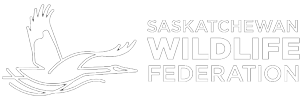SASKATCHEWAN WILDLIFE FEDERATION URGES DRIVERS TO GIVE WILDLIFE A BRAKE
October 20, 2025
As autumn arrives, so does peak wildlife activity across Saskatchewan. During this season, moose and deer are on the move for breeding, dramatically increasing their presence on provincial highways and rural roads. Unfortunately, this rise in movement also means a higher risk of collisions between wildlife and vehicles.
According to the most recent data from SGI, there were 9,053 wildlife-related collisions in 2024, including 8,683 property damage-only incidents, 366 injury collisions, and 4 fatal collisions. These resulted in 443 injuries and 5 fatalities. The majority of these collisions occurred on highways, followed by rural roads, urban streets, and other road types. Saskatchewan’s largest urban centres including Saskatoon, Prince Albert, and Regina, topped the list for wildlife collision frequency.
“Collisions with large animals can cause serious damage, injury, or worse,” says Darrell Crabbe, Executive Director of the Saskatchewan Wildlife Federation (SWF). “By slowing down, staying alert, and watching for movement along the shoulders, especially during dawn and dusk, we can help protect both people and wildlife.”
The SWF and SGI remind motorists that deer are involved in the majority of collisions and that autumn’s shorter daylight hours can reduce visibility when animals are most active. Drivers are encouraged to reduce their speed in high-risk areas, remain alert near wildlife crossing signs, and scan both sides of the road for movement. Remember — if one animal crosses, others may follow.
For more information on how to avoid wildlife collisions or what steps to take if one occurs, visit sgi.sk.ca/wildlife-collisions or contact the SWF Central Office at 306-692-8812.
– 30 –
For media inquiries, please contact:
Darrell Crabbe Tyler McMurchy
Executive Director, Saskatchewan Wildlife Federation Manager, Media Relations, SGI
306-692-8812 | dcrabbe@swf.sk.ca 306-751-1837 | tmcmurchy@sgi.sk.ca
